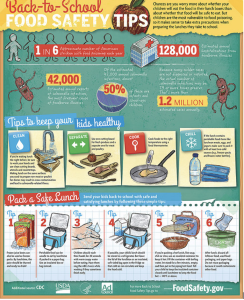All fields are required
Posted in Food Safety,Our Blog on August 19, 2023

It is that glorious time of year when the house is quiet again and a week’s worth of snacks lasts more than 2 days. Kids are back in school. That means they aren’t devouring everything in your fridge and are now somehow managing to survive on their packed lunches or cafeteria fare. How will they survive?!
If your kid snubs their nose at the school’s offerings, you are likely trying to come up with food options for your kiddo to take to school. There is more to consider than simply the decision of sandwich or lunchable. Your packaging decisions could mean the difference between a happy meal and a trip to the nurse’s office.
The Center for Disease Control and Prevention (CDC) says foodborne illnesses cause 128,000 hospitalizations and 3,000 deaths in the U.S. every year. “Young children are a group of the population particularly susceptible to foodborne illness, and serious foodborne illness,” Deputy Under Secretary for Food Safety at the U.S. Department of Agriculture (USDA) Sandra Eskin said.
Bacteria can grow when food reaches temperatures in the “Danger Zone.” This is between 40 and 140 °F. In this temperature zone, harmful bacteria are in their happy space. They wake up and have perfect conditions to multiply rapidly. The best way to minimize risk is to keep cold foods cold and hot foods hot.
Millions of Americans carry “bag” lunches to school or work. While most people don’t give it a second thought, your lunch bag and how you pack it could be setting you up for serious foodborne risk.
Your child’s lunch goes on quite a journey.
It must be kept cold (or hot) on the way to school whether transported by bus, bike, foot, or car and then remain cold (or hot) until it is time to eat. Most schools do not have refrigerators for children to store their lunches, so the lunch box or bag has to do all of the work.
A few simple steps could make a huge difference in packed lunch safety.

Image Credit: FoodSafety.gov
Safe school lunches start with safe preparation. That means buying safe food, separating raw meat from ready-to-eat foods in the shopping cart, transporting food safely home, storing it safely in the refrigerator taking care to keep raw meats and high-risk foods away from produce and prepared foods, preparing lunches safely, and storing them safely in the fridge until you are ready to pack them.
Keep everything clean. Before preparing or packing school lunches, be sure to wash your hands. Use soap and warm water for at least 20 seconds. Start with clean cutting boards, dishes, utensils, and countertops and clean again after you are done. Keep family pets away from kitchen counters.
Avoid cross contamination. It is always best to use separate cutting boards for fresh produce and meat/poultry. Stores even sell color coded cutting boards to reduce the risk of contamination. If this is not available, be sure the cutting board is clean between using it for different types of food. This is particularly important when using the cutting board to cut foods like bread, lettuce, and tomatoes that will not be cooked.
Pay attention to news stories or better yet, go to the source. The U.S. Food and Drug Administration (FDA) publishes current recalls on their “Recalls, Market Withdrawals, & Safety Alerts” page. Check your kitchen regularly to be sure you aren’t including food that has been recalled for safety concerns in your child’s lunch.
You can also follow the Make Food Safe Blog to learn about recall and outbreak news as well as safety tips to help keep your family safe.
By: Heather Van Tassell